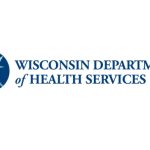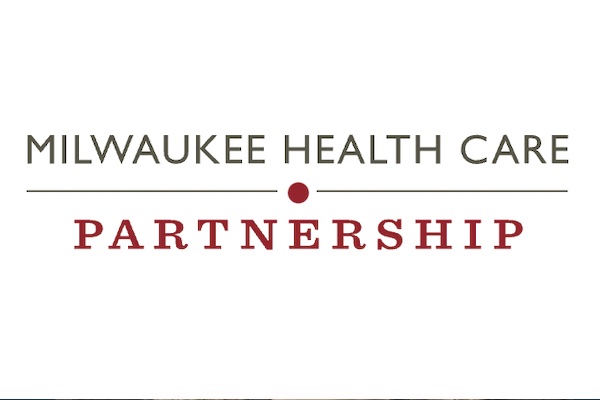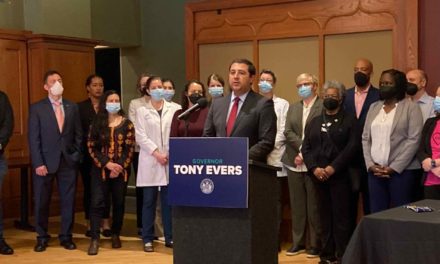
Milwaukee Health Care Partnership uses collaboration to tackle health challenges

The Milwaukee Health Care Partnership brings together organizations across Milwaukee’s healthcare continuum to tackle pressing health challenges, including violence and the uninsured rate.
Launched in 2007, the group includes health systems, community health centers and others.
“It’s in our best interest to work collaboratively,” said Ann Christiansen, who became the partnership’s executive director in September. “That’s part of what’s held the partnership together and will continue to do so.”
Christiansen previously worked for Advocate Health, the owner of Aurora Health Care, and is a former director and health officer for the North Shore Health Department.
She took the reins from Joy Tapper, the founding executive director.
Christiansen and Tapper spoke to Wisconsin Health News last year about the partnership’s work.
Edited excerpts are below.
WHN: What are some of the challenges facing Milwaukee healthcare?
Christiansen: Workforce challenges (are) certainly a pain point right now. Those shortages are across the spectrum, from hospital providers to clinic providers. It’s specialty care, primary care and behavioral healthcare.
Another area is operating costs. As workforce challenges really take hold, and we’re having to increase salaries, reimbursements for services are not keeping pace. Increased operating costs are also a challenge at all levels of the healthcare system.
WHN: How about with the return of Medicaid renewals, following the hiatus during the pandemic?
Christiansen: We’re at a place where we’re really worried about uninsured individuals with the COVID-pandemic-era leniencies around Medicaid winding down. People are having to re-enroll in Medicaid, and that is one area that’s a growing concern. (During the first four months of renewals) we saw about 50 percent of people successfully going through that enrollment process to get back onto Medicaid. We know that in early 2024, the number of people who need to go through the process will increase.
One of the things that we’re worried about in the healthcare space is just the number of people that are going to be without coverage in the next 12 months. We’ve got strategies in place. But we’re really worried that when people get to that point of care and need to have that insurance, they’re going to find out that they’re either not eligible or they’re not enrolled.
WHN: Are there other challenges?
Christiansen: Another area is underinsured people (who might seek) care at a later point in time, rather than keeping on things that are maybe smaller in nature and more treatable. Obviously, that has cost and quality of life implications for people down the road.
One of the things we’ve seen, and I was at Aurora Health Care before this, is disengaged individuals from healthcare for a lot of reasons. Some of it is around trust. Some of it is around these cost factors and accessibility. Some of it is just the complexity of our system and having to navigate to which doctor, which provider. A disengagement of people from their own active healthcare journey is another place where we’re really concerned and seeing a lot of challenges. And then similarly, care navigation around helping people find that right care at the right time and the right place continues to be a struggle.
WHN: What are some of the partnership’s efforts to address workforce challenges?
Christiansen: An exciting one that we’re working on as a collective impact model of pulling different organizations together is the teaching health center. Milwaukee Health Services, the Medical College of Wisconsin and Froedtert Health are collaborating to bring a residency program to Milwaukee Health Services to support their patients. This is one of the first teaching health center residency programs in Wisconsin. We’re really excited to see it launch.
In its first year, there are 14 residents embedded in that health center to provide care for patients on the northwest side and central area of Milwaukee. So that’s one place where we’re trying to work the pipeline, to get individual providers into our area — and not just the numbers of providers, but providers who look like patients whom they’re serving, so we have a diversity in the workforce. We know from research that provides excellent care for people, when it’s by a trusted person that has those cultural competencies.
WHN: How are you responding to the return of Medicaid renewals?
Christiansen: We’ve got the Milwaukee Enrollment Network, which is very active around a number of approaches to help people navigate into care. We’re working with enrollment assisters, like ones that are affiliated with organizations like Covering Wisconsin. Then there are assisters at healthcare plans, health systems and health centers. There’s a whole bunch of navigators that we’re trying to collaborate and coordinate with so that everybody has the same information and is able to be prepared to meet people where they are for that re-enrollment process. So we’re building that workforce and identifying, using our data, where people are in the system and in the process. We can then build up or scale down based on what that volume is. We know it’s going to increase in volume, so continuing to advocate for workforce surges in those time frames.
We’re doing a lot of education and outreach for the community in this area too. Some of it is about raising awareness that people need to actually reapply for Medicaid. We’re working with an organization called INPOWER to do some direct outreach to communities, doing some educational events, doing promotional materials, working social media, all sorts of avenues to raise awareness and help people understand where we are in this process and what they’ll need to do proactively.
We’re also identifying quality improvement initiatives around this re-enrollment process.
Tapper: There are going to be a lot of people who will miss their re-enrollment period and probably learn that they’re uninsured at the pharmacy when they go to pick up their scripts or when they go for a primary care appointment. All of that point-of-care enrollment assistance or a really good linkage system — so that if I come and pick up my script at a pharmacy, they say, ‘Oh here’s where you can go to get a renewal’ — those retrospective things are going to be important probably for the next year and a half.
And then people who are no longer eligible first have to verify that their employer-based coverage, if they have it, is unaffordable per the federal definition before they can even explore a Marketplace plan. We’ve been talking with the business community. They may have more and more employees who didn’t take up their plans coming back to them for special enrollment periods. It’s multi-faceted.
WHN: What are a few of the new initiatives the partnership is pursuing?
Christiansen: Our violence prevention work is exciting, from the healthcare lens of where it is that we’re engaged. There are two initiatives that were started prior to my time. One is the forensic nurse examiner network. That’s really innovative. The health systems are sharing resources around forensic nurse examiners for individuals who have experienced domestic and intimate partner violence and present to emergency departments. That’s providing not only the resources in that emergency department setting, but also advocacy resources beyond that. That’s really an exciting space for healthcare to be.
The other one that we’ve supported through our Shared Community Investment Fund is the expansion of hospital responders that are part of the 414 Life program … to help people who’ve been victimized or perpetrators of violence access resources and navigate the delivery system to get not only physical care, but also mental healthcare.
WHN: Joy, what are the accomplishments of your tenure?
Tapper: They’re shared accomplishments. Part of it is relationships that have been forged among the members and the deeper appreciation they all have of the role they play in the delivery system and that sense of interdependence. So a lot of soft things, in terms of relationships, of working collectively and raising up key programs that have been sustained, like the Emergency Department to Medical Home Program, which is now called Connect to Care Program, the Specialty Access for Uninsured Program, the Housing is Health program, the (Shared Community Health Needs Assessment) and the Shared Community Investment Fund. All of those will have some sort of legacy. In our emerging work in mental health, one of the more visible accomplishments was the joint venture Mental Health Emergency Center. But more importantly, it’s the creation of the broader delivery system.
WHN: Ann, what is your vision for the partnership?
Christiansen: By having a good delivery system, we influence health behaviors. We influence the social and economic conditions that people are living in. All of these things work together. So my role and my vision is to keep the partnership in the core work that it has been doing, but then also to really look at where healthcare can be in these other lanes.
For example, with social drivers of health, we have work happening in the housing space, with our Housing as Health program. We’re helping people who are presenting to emergency departments and clinics without stable housing navigate into the resources that exist in Milwaukee County. Often, there’s a disconnect between people who are seeing providers for care, and then getting into that system. So we are working with this model of creating that bridge for individuals. I think that’s a great space to be in. It’s very specific to healthcare and the resources healthcare has, without tackling the whole complexity of the problem.
I would continue to have us support and be part of the work in the violence prevention area, with the city of Milwaukee continuing to take a leadership role in this. But again how can healthcare support people in that recovery and support area? It’s a great space for healthcare to be. So I think it’s important to be focused, but also nimble, on those emerging challenges.
This article first appeared in the Wisconsin Health News daily email newsletter. Sign up for your free trial here.





